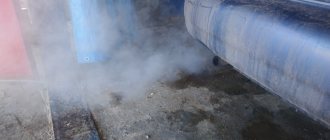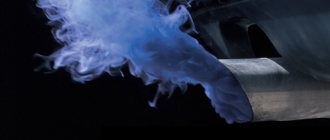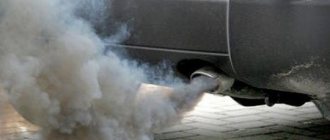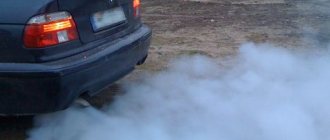Smoke of different colors can come out of the exhaust pipe of a diesel engine: black, blue, gray, white. Each of these shades is clearly distinguishable when exhausted. Car owners are often interested in why a diesel engine smokes.
For high-quality control over the functioning of the power unit, it is necessary to conduct a thorough analysis of the shades and colors of the exhaust gases. The color of the diesel engine exhaust provides comprehensive information about the condition of the engine components and parts.
This allows you to eliminate malfunctions in the systems and components of the power unit, check the condition of the parts of the cylinder-piston group, gas distribution mechanism, eliminate failures of nozzles, fuel injection pump elements, etc.
Main signs of normal operation of a diesel engine
White smoke from the exhaust pipe of a diesel engine is a product of combustion of the air-fuel mixture, which is in a gaseous state. With optimal settings, a warmed-up diesel engine does not smoke. Normal engine operation is accompanied by the release of white water vapor, noticeable in winter when the ambient temperature is low.
The appearance of shades in diesel exhaust gases indicates a malfunction in the power unit. The color of the exhaust gas can be in various options:
- white-gray;
- gray;
- grayish blue;
- black smoke with soot.
What color is the exhaust considered normal?
The exhaust gases of diesel and other engines are “products” of combustion in the cylinders of the working mixture, these are exhaust gases. When a diesel engine is running normally, without interruptions, smoking is possible immediately after starting. Once it warms up, the color of the exhaust becomes virtually transparent. During the cold season, white smoke is steam, usually caused by condensation. A faulty motor can produce smoke of the following colors:
- Thick black (with soot)
- Gray (gray with blue)
- White (grayish tint)
This is interesting: How should pedestrians move along the right edge of the roadway?
How to distinguish white smoke from water vapor
To determine what quality of smoke comes out, you need to bring a white sheet of paper closer to the outlet of the pipe of a warm engine. Water stains quickly evaporate, leaving the paper clean. Bold marks on the paper indicate the presence of oil inclusions in the exhaust.
Smoke containing oil fragments is thicker and has a characteristic burning smell. When oil is present in the exhaust gases, increased consumption of engine oil is observed.
How to find the cause of engine overheating
If the engine is constantly heating up and white smoke is coming out of the muffler pipe, you should first check:
- oil in the engine crankcase, it should be a normal dark color. White or too light color of motor oil indicates that antifreeze or antifreeze got into it, and an emulsion formed when mixed;
- heating of the radiator pipes, when the upper hoses of the cooling system are hot and the lower hoses are cold, the thermostat is most likely faulty and the coolant flows in a small circle;
- presence of coolant in the radiator; if there is little of it, you should immediately turn off the engine, wait until it cools down a little, then add antifreeze to the cooling system.
Also, the cooling system can “air up”, but as long as the cylinder head gasket is sealed, almost no white smoke comes out of the muffler pipe. When the gasket overheats, it breaks through quite quickly, so you can’t drive with an elevated temperature in the cooling system; you need to look for the cause and eliminate the defect.
Exhaust gas formation process
Diesel fuel, being under high pressure, is injected into the cylinders through a special sprayer - an injector. The diesel fuel is sprayed into small fragments in the cylinder. The smallest particles of diesel fuel are heated in the combustion chamber and actively evaporate.
The operation of a four-stroke engine takes place in several stages:
- Obtaining a sprayed portion of fuel at a given time both at idle and when operating under load, when the cylinder piston is in the upper position, i.e. at the moment of compression.
- Self-ignition of the air-fuel mixture due to compression and high temperature.
- Complete combustion with maximum return of useful energy to the piston.
- Exhaust gases exiting the cylinders.
How to check the thermostat
Very often, the cause of engine overheating is a faulty thermostat. The valve does not open and does not allow the coolant to flow in a large circle, as a result of which the engine gets very hot. Checking the thermostat is easy, but to do this it must be removed from the engine. We check as follows:
- take a small metal dish;
- pour water into it;
- place a thermostat in the container;
- put the pan on the fire, you can place an electric boiler in the water;
- heat the water.
Causes of white smoke
When warming up a cold diesel engine, the release of white smoke is normal, since this is water vapor formed during the evaporation of condensate formed from the air while the car is idle. Some moisture pours out of the exhaust pipe when the engine starts, the rest of the water evaporates.
As all parts of the exhaust system warm up, moisture and steam completely disappear. In winter, the release of steam is longer and more intense due to the slow heating of components and parts.
White smoke appears for the following reasons:
- Increased humidity of components and parts of the exhaust system when warming up.
- Inadequate combustion of diesel fuel in cylinders.
- Faulty glow plugs.
- Insufficient compression level in the cylinders.
- The flash in the combustion chambers occurs with some delay.
- Failure of the fuel pump plungers and bushings.
- Penetration of coolant into the engine cylinders.
- Presence of condensate in the exhaust system.
Diesel smokes white exhaust
Fuel injection of a diesel unit means that fuel is supplied to the cylinders under high pressure through a diesel injector. As diesel fuel passes through the nozzle, a so-called spray pattern is formed, due to which the supplied fuel is evenly divided into small drops in the diesel cylinder. Next, the sprayed fuel particles inside the cylinder are heated, and their active evaporation begins.
A fully operational four-stroke diesel engine in any operating mode (idling or under load) of the unit receives an effectively atomized portion of fuel at a clearly defined moment after the compression stroke in the engine cylinder. Next, the mixture self-ignites due to heating. Afterwards, the fuel-air working mixture of diesel fuel and air burns completely, giving maximum useful energy to the piston. The result is the release of exhaust gases from the cylinder. White smoke from a diesel engine pipe occurs for the following reasons:
- increased humidity in the exhaust system during warm-up;
- fuel may not burn completely in diesel cylinders;
- coolant entering the internal combustion engine cylinders;
Condensation in the exhaust system
For the warm-up mode of a cold engine, white exhaust from a working diesel engine is normal. In fact, the white color comes from water vapor in a car's exhaust system. Water condenses from the air after the machine is idle. After starting the engine, part of the condensate flows out in the form of water droplets and collects at the end of the exhaust pipe, while the other part of the water begins to evaporate. After heating the exhaust system of a diesel or gasoline engine, water and condensed steam usually disappear. The exception is the winter period. The lower the temperature outside, the longer and more intense the vaporization occurs. The reason is that the exhaust system heats up noticeably slower in cold weather.
Diesel does not burn completely
Also, white exhaust during warming up of the diesel engine occurs due to untimely self-ignition of the working mixture in the cylinder. The whitish-gray color of the exhaust indicates the presence of gases that should have pushed the piston in the cylinder, but ended up in the exhaust.
Note that this phenomenon is characteristic of both a serviceable diesel engine during the warm-up process in winter and a faulty diesel engine. In the first case, diesel fuel enters the cylinder and evaporates, but complete combustion of the mixture does not occur, taking into account the fixed angle of fuel supply. This is caused by insufficient temperature inside the cylinder for timely ignition, which immediately goes away with the heating of the internal combustion engine and is not a malfunction.
The appearance of white exhaust with a grayish tint on a fully warmed-up diesel engine indicates deviations from the norm. The reason is the same delay in self-ignition of the fuel in the combustion chamber as a result of an impaired fuel supply angle, but this occurs after the engine has reached operating temperature.
If the diesel smokes white, this indicates that the diesel injectors are supplying and spraying diesel fuel normally. Flash delay leads to a decrease in the temperature in the cylinder, the speed and uniformity of combustion of the mixture decreases, regardless of the efficiency of fuel atomization by the nozzle. In this case, the white color of the diesel engine exhaust indicates:
- problems with glow plugs;
- compression drop in cylinders;
- wear of injection pump plunger pairs;
- increased injection pressure of injectors;
We also recommend reading the article about the design of the diesel engine power system. From this article you will learn about the design features, components and operating features of the fuel system of a diesel internal combustion engine.
With such malfunctions, the diesel engine begins to experience difficulty starting “cold” and/or “hot”; the diesel engine may stall and operate unstably at idle and under load. The power unit loses power, acceleration dynamics decrease, fuel consumption increases noticeably, and the internal combustion engine’s response to pressing the gas pedal becomes less clear.
Coolant in cylinders
The presence of very thick white smoke in the exhaust of a heated diesel engine can be caused by coolant entering the engine cylinders from the cooling system of the power unit. The color of the exhaust may change, since the presence of antifreeze or antifreeze in the combustion chamber causes the diesel engine to smoke white, grayish or white-blue smoke. This depends on the components that make up the coolant in the cooling system. The density of the smoke is also affected by the outside air temperature (at negative temperatures, the exhaust becomes thicker).
The main cause of diesel smoke in this case is the water contained in the coolant. It actively evaporates from contact with heated components. The result is copious amounts of fog from the exhaust pipe. This malfunction is especially dangerous for a diesel engine compared to a gasoline car. The sulfur content in diesel fuel is increased, the temperature in the cylinder is high, and the ingress of water from the coolant leads to the active formation of sulfur oxide. The presence of sulfur dioxide has a detrimental effect on the service life of the diesel engine and associated systems.
Coolant will enter the cylinders as a result of the fact that the cylinder block (BC) gasket may be punctured, deformed, or burnt out. Another common cause is a crack in the cylinder head (cylinder head) or in the cylinder block itself. Liquid can also enter the internal combustion engine cylinder through the intake system. This is caused by a leaky intake manifold gasket, if this is structurally possible on a particular engine.
Additionally, liquid penetration into the cylinders can be diagnosed by monitoring the condition of the cooling system, checking the coolant level, as well as by the presence of exhaust gases (gas plugs) in the engine cooling system. To do this, simply unscrew the radiator cap or expansion tank. The smell of exhaust gases and/or an oil film on the surface of the coolant will indicate the diagnosis. When liquid enters the cylinders, the level will naturally decrease. If you start a cold engine without tightening the expansion tank cap, then the pressure in the cooling system will increase, the coolant level in the expansion tank will rise, but will be unstable. Gas bubbles will also appear in the tank, and coolant may spray out of the filler neck of the tank.
If the engine is turned off, fluid from the cooling system will begin to enter the cylinder, pass through the piston rings and end up in the engine oil. This is how antifreeze gets into the engine oil pan. Gradually the oil will mix with the coolant. The result will be the appearance of an emulsion. The engine oil itself becomes visually lighter and loses its luster upon contact with the liquid. The beneficial properties of the oil are lost. Penetration of the emulsion into the lubrication system will cause the appearance of a characteristic light brownish-yellow foam. This foam will be deposited on the valve cover and oil filler plug.
Small microcracks mean that there may be no signs of gases and oil entering the cooling system. The amount of coolant in the engine oil in case of such damage is not large, the oil may look clean, the process of foaming under the valve cover plug is present, but it is not intense.
More serious damage leads to active accumulation of coolant in the space above the piston, which makes it difficult to start the internal combustion engine (heavy rotation of the crankshaft by the starter). Excessive coolant leaks into the cylinder can lead to water hammer, bent connecting rods and major repairs.
It should be added that such problems are often associated with previous overheating of the diesel engine. In parallel with eliminating the main problem, the cooling system may also require a thorough inspection. It is necessary to ensure the functionality of the thermostat, radiator, radiator and expansion tank caps, cooling fan, serviceability of the fan switch sensor, integrity of the pipes and reliability of connections.
The dangers of incomplete combustion of diesel fuel
Partial combustion of diesel fuel results in a smoke-white color. An untimely flash of air-fuel mixtures in the cylinders leads to the release of whitish-gray gas, which did not have time to fully push the piston and ended up in the exhaust pipe.
In working diesel engines, this happens when starting the engine in winter. The temperature in the cylinders is not sufficient for self-ignition, the diesel fuel evaporates and the mixture does not burn completely. This is not a defect, since the smoke completely disappears as the engine heats up.
A serious deviation from the norm is characterized by the appearance of a white-gray exhaust when the engine is warm. Here, self-ignition is observed with a delay due to untimely supply of diesel fuel by the injectors, but the engine temperature at the same time has a sufficient operating value.
If the injectors supply and spray fuel without delay, but white-gray smoke is still released, the air-fuel mixture does not burn completely due to a decrease in temperature in the cylinders due to poor quality glow plugs, a decrease in pressure levels, and defects in fuel pump parts.
These malfunctions lead to the following problems:
- difficulties that arise when starting the power unit, both cold and warm;
- the appearance of a tripping effect in a diesel engine;
- engine instability at idle and under load;
- drop in power unit power;
- deterioration of acceleration dynamics;
- increased fuel consumption;
- decreased engine response to the gas pedal.
Injector malfunction
It's no secret that the quality of diesel fuel sometimes leaves much to be desired. If the car often runs on low-quality diesel fuel, the service life of the injectors is greatly reduced. Clogged channels are one of the main problems of diesel units. Also, the operation of the injectors is affected by factors such as wear of the nozzle or insufficient pressure of the injection elements.
Due to improper operation of the injectors, little diesel fuel may enter the cylinders, or it will be poorly atomized. In both cases, the combustion process, and therefore the operation of the motor, will be disrupted. And since parts wear unevenly, most often the injectors spray fuel differently. Therefore, the cylinders also do not work the same way. Eventually, the driver will begin to feel the vibration characteristic of a revving engine. Therefore, experienced drivers advise changing diesel injectors every 150 thousand km.
If the engine seizes up, then the only way to identify a non-working injector is by moving it to another cylinder. If after this “manipulation” the cylinder refuses to work, then the problem is in the injector.
Remember that repair or cleaning of injectors in this case must be carried out in conjunction with adjusting the injector and checking the operation of the injection pump.
What is the effect of coolant entering the diesel combustion chambers?
When liquid from the cooling system enters the combustion chamber of a heated diesel engine, an exhaust saturated with thick white smoke appears from the pipe. The color of the smoke may change from white to gray as the antifreeze burns. The components that make up the coolant affect the color of the exhaust gases. The density of the smoke depends on the ambient temperature; in cold weather, the exhaust has a thicker consistency.
The water in the antifreeze actively evaporates, hitting the hot parts, and comes out of the pipe in the form of abundant fog.
The diesel engine especially suffers from this malfunction: diesel fuel becomes more saturated with sulfur, which leads to the formation of a colorless gas with a suffocating odor - sulfur oxide. When operating under such conditions, the service life of a diesel engine sharply decreases due to the rapid failure of its elements.
Prevention of "disease"
- check the antifreeze level in the expansion tank. Both using sensors and directly looking at the tank.
- antifreeze should not go away and change greatly in volume, but it needs to be updated - ideally, at least once a year
Even on cars with decent mileage, adding coolant is required little and rarely. If you need a new dose of antifreeze before each trip, your next destination is a service center. Preferably, official, with smart specialists and equipment. Because it's a serious matter.
The antifreeze has “evaporated” again - urgently go to the service center!
Are you waiting for a sign from above to help you realize that you can’t delay any longer?! Here he is! The faster the symptom of white smoke from the exhaust pipe is cured, the “less bloodshed” (less expense and nerves) you will get away with.
It is better, of course, that such serious problems do not happen in your auto history. So take care and love of your car and it will love you back.
This is interesting: How to change a low beam bulb on a viburnum
Black smoke, alarm
The release of black smoke may indicate serious problems with the car. That is why, as soon as black smoke is detected, you should immediately contact a service center or fix the problem yourself, if possible. A similar situation occurs when the fuel is not completely atomized.
Another very common cause of black smoke is high fuel consumption. In such a situation, you need to check the injectors and fuel pressure regulators. The best place to start your inspection is with the air filter. If the fuel line is severely clogged, this can also cause black smoke, however, this situation does not occur very often.
First of all, you need to regularly and promptly change the filter elements. This advice will be useful for all owners of diesel vehicles. At the same time, in the future it will be possible to save quite a lot of money, and most importantly, avoid serious breakdowns.
There is a problem with older cars where they begin to emit black smoke when accelerating. In such a situation, it is best to refuse to refuel in dubious places. Poor quality fuel can clog injectors.
The appearance of black smoke in pure diesel vehicles is very alarming. New generation cars have special electronic sensors that help reduce smoke problems.
Fuel
The less often we refuel the car, the wiser it is to refuel with premium diesel fuel in winter. From regular diesel fuel, paraffin has the right to precipitate at a temperature of -20ºC - even if today it is only -5ºC, in two weeks it could be -25ºC - and then we simply won’t start the engine! Although fuel sellers have to adjust the quality of even basic diesel fuel to prevailing weather conditions, firstly, not all of them work quickly enough, and secondly, the fuel sometimes remains in the tank for several weeks. Investments in quality fuel will pay off.
Diesel engine emits gray smoke
Fuel and winter
The system has two mechanisms. This is the injection pump and the injection pump injector. Very often the first element fails because its design is more complex than the second. The pump cannot create pressure in the fuel system, so the diesel engine will not start or is difficult to start. The trip is accompanied by “sneezing” (as if the car is running out of fuel). It is worth paying attention to the fact that the belt goes to the injection pump. It may tear or fall off. First of all, you need to check the belt drive. Check the fuel system fuses (going to the pump). One of them can be blown up. This often occurs due to a short circuit. Experienced drivers are advised to always keep a set of spare fuses in their glove compartment.
Incorrect operation of the injection pump
When a diesel engine stalls when cold, you should pay attention to the operation of the high-pressure fuel pump. If the engine starts from a tug, but refuses to run under normal conditions, most likely there is not enough fuel entering the combustion chamber. And this indicates the unsuitability of the injection pump plunger pair. That is, the pump is not able to push fuel through the injectors at the required pressure.
The process of fuel injection pump breakdown is usually quite lengthy. At the very beginning, the engine will simply stall when cold, then it will start from a tug, and then it will refuse to work at all. Therefore, it is necessary to eliminate the breakdown as early as possible. But it is very difficult to prevent such a problem, since in the vast majority of cases the operation of the plunger pair depends on the quality of the fuel, which in our country is of rather low quality.
When inspecting the injection pump, pay attention to the tightness of the pipelines. If the fuel line sucks in air, the engine will stall both cold and hot.
Injection advance
Another problem associated with the operation of the fuel injection pump is injection advance. It is known that the time the fuel spends in the combustion chamber affects the quality of its production. The better the fuel mixture is heated, the higher the efficiency, while the smoky exhaust from your engine becomes minimal. Therefore, some manufacturers deliberately equip diesel engines with heating devices. Thanks to this, the idle speed remains high during a cold start. And the injection accordingly becomes earlier. After warming up, the engine operates as usual.
However, if the injection advance occurs arbitrarily, the engine wears out faster and runs harder. This happens due to the fact that the pressure inside the fuel injection pump does not correspond to the engine speed. There may be several reasons for this problem:
- Stretched belt;
- Clogged fuel filter;
- Wear of the pump itself;
- Pressure reducing valve.
Depending on the cause of the breakdown, injection may be disrupted in a certain speed range or in all of them at once. However, it can be adjusted using the vehicle's operating instructions. But, without knowing the exact cause of the breakdown, it will have to be constantly adjusted. Therefore, it is best to completely inspect the pump and fix the problem, rather than operate a worn injection pump.
If you find that a diesel engine misfires when cold and smokes white smoke somewhere on the road, there is no need to call a tow truck. It is not advisable to drive a faulty engine, but you can get to the workshop or garage on your own. However, you should not delay repairs. Vibration will very quickly damage the engine and instead of just a few parts, you will have to replace the entire engine.
Results
Strong-smelling gray exhaust gas may indicate that the engine's air-fuel mixture is too rich. The fuel level may be too high, for example due to a faulty temperature sensor.
- There are many reasons why a diesel engine does not start in cold weather.
- To successfully combat diesel in winter, you need to prepare for the onset of cold weather:
- charge the battery (replace with a new one), make sure that the generator is in good technical condition
- replacing engine oil and filter
- check the serviceability of the glow plugs
- replace fuel filter
- changing fuel to winter
- drive with a full tank of gas
In most cases, if these measures are followed, problems with starting a diesel engine at low temperatures will not arise.
The article describes the reasons why a diesel car (diesel engine) does not start for the following brands of cars:
However, if the engine does not start cold, try adding warm fuel to the tank or warming up the diesel engine by pointing a construction (household) dryer to the fuel filter and gas tank. After 10-15 minutes, only warm fuel will flow back into the tank, and only then you can hit the road.
If the problem is a discharged battery, try to “ignite” the engine, or better yet, remove, heat and charge the battery.
Search for reasons
Why does water get into the engine:
- Broken or burnt gasket between the head and the block.
- Cracks inside the cylinder block or inside the head are possible.
Such a malfunction can be identified by checking the coolant level and by the appearance of “gas plugs” inside the cooling system:
- We unscrew the radiator cap, as well as the expansion tank.
- If an oil film appears on the surface of the coolant, or the smell of exhaust gases, this clearly confirms the diagnosis.
- Reduced coolant level.
- Gas bubbles inside the expansion tank.
- The appearance of water in the engine oil. The oil emulsifies and turns brownish-yellow.
- Brown-yellow foam can be visible on the engine oil filler cap and on the expansion tank cap.
Such a breakdown does not occur out of the blue; the cause of such a breakdown is either severe overheating of the diesel engine, or its “defrosting” (this happens when the water is not drained in winter after the engine is turned off).
Overheating causes the gasket to burn out, and from defrosting, water expands the cooling system, also causing the metal to crack.
If you do not find such symptoms (that is, the coolant does not get into the oil), then urgently go to a service station, it is not possible to check the injection pump or injectors yourself, without a special stand.
If, on the contrary, the penetration of coolant into the cylinders or lubricants into the coolant is confirmed, further operation of the diesel engine is prohibited. Immediate overhaul only. Perhaps it’s just a matter of the gasket, then you’ll get off easy with timely repairs.
Ignoring the problem - it drives, even though it is tripping, it means it is working, will lead to the destruction of the cylinder-piston group, and then the cylinder block can break.
Yes, my friends, a torn connecting rod breaks the block and engine sump, the same thing happens if the piston crumbles, I have witnessed this phenomenon more than once.
The design of the diesel engine is unique, it will work and the car will move with difficulty if at least two cylinders are working! Unlike gasoline.
A decrease in compression in the cylinders occurs due to incomplete closing of the valves, or due to stuck compression rings. To check this:
- It is enough to inject 5 cubes of diesel engine oil into each cylinder through the hole of the spark plug or injector (they will have to be unscrewed).
- There will be no harm to the engine, take my word for it.
- But an increase in compression will immediately tell you that the problem is in the piston rings; if the compression has not changed, then the valves are not closing.
The problem with compression due to the rings can only be treated by replacing them, and the problem with the valves can be solved by removing the head, followed by cleaning and grinding the valves. I already wrote on my website how to grind valves.
In conclusion, I want to say that you saw white smoke from a diesel engine, no need to panic, wait until it warms up, maybe everything will return to normal. At the slightest suspicion, check the condition and level of coolant. If the fuel injection pump or injectors are suspected, go check it at a service station.
That’s all I have, thanks to everyone who reads me, subscribe to site updates and learn a lot more useful things, share links with friends on social networks, they will also find a lot of useful things for themselves. See you.
Smoke of different colors can come out of the exhaust pipe of a diesel engine: black, blue, gray, white. Each of these shades is clearly distinguishable when exhausted. Car owners are often interested in why a diesel engine smokes.
Diagnostics of the cooling system operation
To find the reason for the penetration of antifreeze into the engine cylinders, you need to check the cooling system:
- Check the antifreeze level in the expansion tank.
- Eliminate the formation of air pockets in the lines.
Algorithm of actions when carrying out verification activities:
- remove the cap from the expansion tank;
- check the amount of antifreeze;
- start a cold diesel engine without closing the expansion tank plug;
- turn off the engine.
If the coolant has access to the combustion chambers, a characteristic burning smell appears in the tank and oily films appear on the surface.
When antifreeze is mixed with oil in the crankcase, the beneficial properties of the lubricant are lost. The lubricant becomes lighter and its characteristic oiliness disappears. As a result, brown foam is formed, which, when deposited on the valves, leads to the formation of cracks. The resulting emulsion in the oil contributes to accelerated wear of the entire piston group, cylinders and many other important elements of a diesel engine.
The greatest harm is caused by infiltrated coolant when it accumulates above the pistons - starting a diesel engine is difficult, the crankshaft rotates heavily. Coolant leaks lead to hydraulic shocks, deformation of engine components, and major repairs cannot be avoided.
Faults in the cooling system can cause serious damage to the engine. If white smoke appears, it is urgent to check the functionality of the following components:
- thermostat;
- radiator;
- expansion tank cover;
- fan;
- condition of pipes and pipes;
- tightness of joints.
White smoke in the exhaust gases of a heated diesel engine indicates serious defects in the power unit. Such a motor requires urgent, thorough diagnostics and mandatory qualified repairs. It is not recommended to operate a car that emits white smoke rather than steam.
In order to diagnose the normal operation of a diesel car engine, it is enough to pay attention to the color of the exhaust gases of the power unit. Based on the color of the smoke from the exhaust pipe, it is possible to accurately diagnose the condition of the power unit. This will make it possible to replace worn parts in a timely manner and prevent more serious malfunctions:
- piston group;
- gas distribution mechanism;
- failure of the power unit injectors;
- Injection pump.
Smoke from a car chimney is a product of combustion of a mixture of fuel, which after processing turns into gas. If a properly tuned diesel engine is perfectly tuned, the exhaust may only be visible in the form of white water vapor in the winter. If negative changes occur in the internal combustion engine, then the color of the diesel engine exhaust lets you know about engine malfunctions. The color of the exhaust varies. It is he who gives us information about the nature of a possible engine problem. Depending on the malfunction, the color is:
- thick black, such smoke contains a lot of soot;
- white, with a gray tint;
- grayish-blue, similar to gray.
The engine runs rough both on gas and at idle speeds
Interruptions in engine operation in all modes indicate either problems in the power system or irregular valve timing. But, however, there may be more serious problems - such as burnout of the piston crown or breakdown of timing parts (for example, breakage of valve springs or burnout of a valve).
Interruptions in engine operation in all modes indicate either problems in the power system or irregular valve timing. Typical malfunctions of the power system include clogging of injectors, fuel filters, air leaks and are determined during complex diagnostics https://diesel-remont78.ru.
Even cleaning the injectors of a modern diesel engine requires quite expensive equipment, let alone repairing the injection pump... Therefore, if the diesel engine is running “hot” at idle, it is best to contact a qualified specialist. Self-repair can lead to unjustified expenses - if you randomly replace parts, then diagnostics and repairs will cost a pretty penny. Sometimes, even for a specialist, it’s a mystery “why does a diesel engine stall?” becomes a tough nut to crack - modern fuel equipment cannot be diagnosed by eye, and the abundance of electronics does not make the task easier. If old diesel engines could operate practically under water (provided that it did not enter the intake tract), then a modern engine can simply stall in wet weather.
We recommend: The dashboard of the domestic “Seven” and its features
Compression
It should also be remembered that, in addition to the ignition method, these engines differ in the design of the fuel system. And if gasoline ones have a simple submersible pump, then there are two of them: one for low pressure and the other for high pressure. Well, let's look at why diesel is not "hot".
What is normal compression?
Initially, its level is twice as high as that of gasoline units. The mixture ignites as a result of strong compression. And loss of compression does not have the best effect on engine starting. Since each compression process is accompanied by the release of thermal energy, the mixture does not heat up enough and cannot ignite. If it's a high-mileage car, compression decreases as the cylinder walls wear and rings rupture. Recall that each piston has three rings. Two compressions, one with an ice scraper. Here it is necessary to disassemble and repair the engine. It happens that compression drops in only one of the cylinders. In this case, the diesel engine may start and either stall or fail. This means that one of the cylinders is faulty or the ignition is unstable.
Smoke from the muffler pipe with a bluish tint
Some motorists confuse blue smoke with white smoke and believe that they are the same thing. Blue smoke is always accompanied by increased oil consumption and indicates a malfunction of the cylinder-piston group. Reasons for the appearance of bluish exhaust from the pipe:
- wear, scoring in the cylinders;
- wear, breakage of piston rings;
- burnout of pistons;
- hardening of valve stem seals.
The partitions between the piston rings on the pistons may also burst, and the valve guides in the cylinder head may wear out. When blue smoke comes out of the chimney, it is often accompanied by knocking in the engine, and with such signs, you should not continue to operate the car; a major overhaul is required.
Related articles:
- Engine detonation - causes, solutions Modern cars are equipped with four-stroke gasoline and diesel engines, which were developed back in the late 19th century, despite significant progress in
- The engine does not start when the starter clicks: the main reasons, diagnostics, troubleshooting. A car’s unexpected refusal to start can upset any car owner, especially if you need to go somewhere urgently, and it’s difficult to figure out what the problem is right away. When
- Causes and signs of catalyst clogging, diagnostics, solution to the problem The catalytic converter (or another name for the catalyst) is installed on all modern cars, designed to clean exhaust gases from harmful impurities, reduces the level










